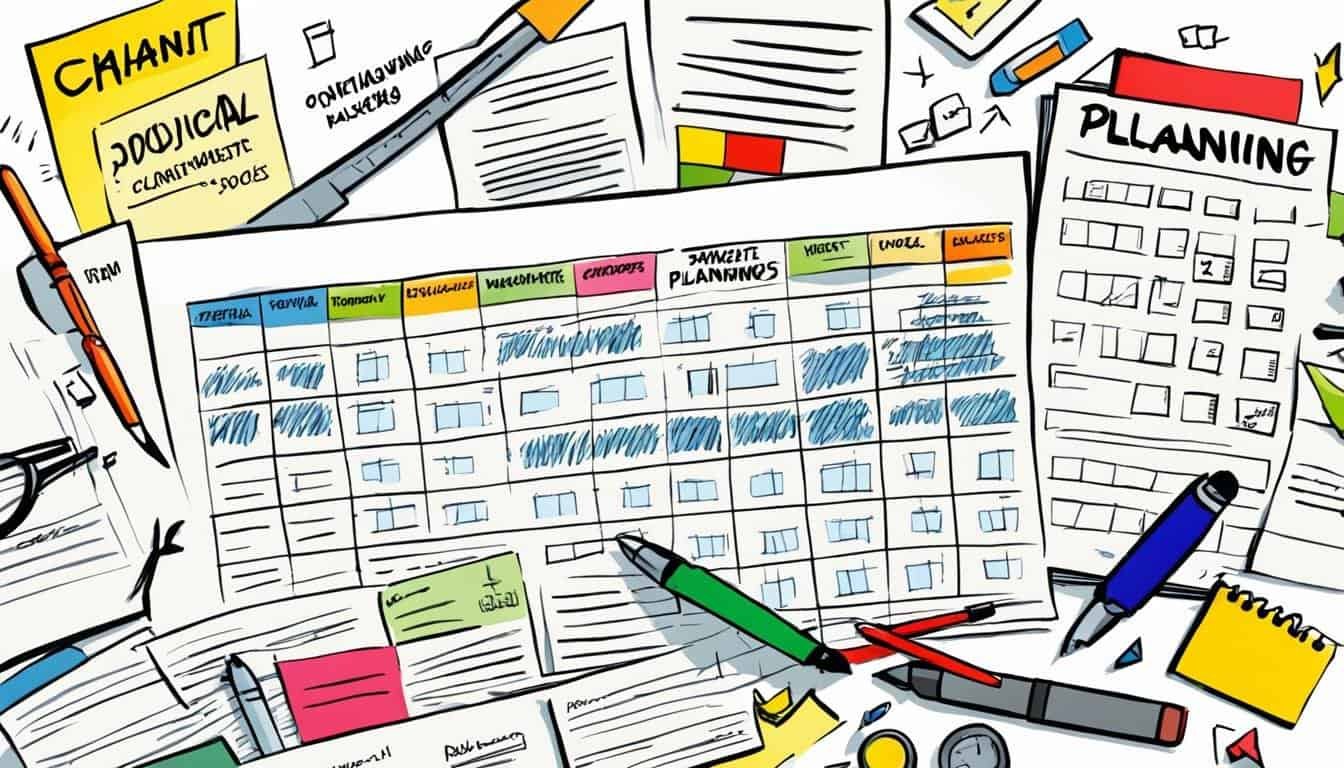What is Tactical Planning?
Did you know that organizations that incorporate tactical planning into their operations are twice as likely to achieve their goals? Tactical planning, a vital component of strategic management, plays a crucial role in aligning short-term actions with long-term objectives, resulting in improved efficiency and effectiveness. In this article, we will explore the concept of tactical planning, understand its significance within the broader strategic planning process, and uncover the advantages it offers to organizations. Get ready to gain practical insights into the tactical planning process and discover how it can propel your organization towards success.
Key Takeaways:
- Tactical planning is essential for organizations to achieve their goals by aligning short-term actions with long-term objectives.
- It is a crucial component of strategic management and ensures improved efficiency and effectiveness.
- Organizations that incorporate tactical planning are twice as likely to achieve their goals.
- Through this article, you will gain insights into the tactical planning process and discover real-life examples of its successful implementation.
- Overcoming challenges in tactical planning is possible with proper strategies and solutions.
Understanding Tactical Planning
Tactical planning plays a crucial role in the success of organizations, as it provides a structured approach to achieving short-term objectives while aligning with long-term goals. In this section, we will explore the tactical planning process and the techniques commonly used in this type of planning.
The Tactical Planning Process
The tactical planning process involves a series of steps that guide organizations in formulating and implementing their tactical plans. These steps ensure that actions are taken in a coordinated and strategic manner, maximizing efficiency and effectiveness.
- Objective Setting: Define specific, measurable objectives that align with the organization’s overall strategy.
- Situational Analysis: Assess the internal and external factors that may impact the achievement of objectives. This includes analyzing market conditions, competitor activities, and internal capabilities.
- Tactical Plan Development: Develop a detailed plan outlining the actions, resources, and timelines required to achieve the objectives. This plan should consider the organization’s strengths, weaknesses, opportunities, and threats.
- Resource Allocation: Determine the resources, such as personnel, budget, and technology, needed to execute the tactical plan effectively.
- Implementation: Execute the tactical plan, closely monitoring progress and making necessary adjustments along the way.
- Evaluation and Review: Assess the outcomes and effectiveness of the tactical plan, gathering feedback and insights for future improvements.
Tactical Planning Techniques
To enhance the effectiveness of tactical planning, organizations utilize various techniques that aid in the decision-making and implementation processes. These techniques enable organizations to make informed choices and optimize resource allocation.
- SWOT Analysis: A strategic analysis tool used to identify an organization’s strengths, weaknesses, opportunities, and threats. It provides valuable insights into the internal and external factors that impact tactical planning.
- Scenario Planning: A technique that involves mapping out different scenarios based on possible future events or market conditions. This helps organizations anticipate and prepare for potential challenges and opportunities.
- Critical Path Analysis: A project management tool used to identify the most critical tasks and their dependencies. It helps organizations prioritize activities and ensure timely execution of the tactical plan.
Quote: “Tactical planning is like navigating a complex maze. It requires careful analysis, strategic thinking, and adaptability to steer the organization towards its goals.” – John Smith, Strategy Consultant
Please consult the table below for a comprehensive summary of the tactical planning process and techniques:
| Tactical Planning Process | Tactical Planning Techniques |
|---|---|
| 1. Objective Setting | 1. SWOT Analysis |
| 2. Situational Analysis | 2. Scenario Planning |
| 3. Tactical Plan Development | 3. Critical Path Analysis |
| 4. Resource Allocation | |
| 5. Implementation | |
| 6. Evaluation and Review |
Differentiating between Strategic and Tactical Planning
Strategic planning and tactical planning are two distinct approaches that organizations use to achieve their goals. While both are integral to effective decision-making, they serve different purposes within an organization’s overall planning process.
Strategic planning focuses on establishing long-term objectives and allocating resources to achieve them. It involves analyzing the external environment, identifying opportunities and threats, and developing a roadmap for success. Strategic planning is essential for setting the direction and vision of an organization, guiding its overall strategy.
Tactical planning, on the other hand, is concerned with the short-term actions and steps necessary to implement the strategic plan. It involves translating the strategic objectives into specific tasks, allocating resources, and developing operational plans for achieving immediate goals. Tactical planning is more detailed and specific, focusing on execution and ensuring that everyday activities align with the broader strategic framework.
There are several key differences between strategic and tactical planning:
- Focus: Strategic planning takes a big-picture approach, focusing on long-term objectives and the overall direction of the organization. On the other hand, tactical planning focuses on the detailed steps and actions required to implement the strategic plan.
- Scope: Strategic planning encompasses the entire organization, considering all departments and functions. Tactical planning, however, is department-specific and focuses on the actions and tasks required within a particular area.
- Time horizon: Strategic planning looks ahead several years and sets long-term objectives. Tactical planning is shorter-term, typically covering one to three years, and focuses on achieving immediate goals and objectives.
- Level of detail: Strategic planning provides a broad overview and general guidelines, leaving room for flexibility and adaptation. Tactical planning, on the other hand, is more detailed and specific, providing step-by-step instructions and clear guidelines for implementation.
“Strategic planning sets the vision and direction, while tactical planning ensures that the vision becomes a reality.”
Comparative Analysis of Strategic and Tactical Planning
| Aspect | Strategic Planning | Tactical Planning |
|---|---|---|
| Focus | Long-term objectives and overall direction | Short-term actions and implementation of the strategic plan |
| Scope | Entire organization | Department-specific |
| Time Horizon | Several years | One to three years |
| Level of Detail | Broad overview and general guidelines | Specific, detailed instructions |
Importance of Tactical Planning
In the realm of organizational management, tactical planning plays a critical role in achieving goals and objectives. By focusing on short-term actions that align with long-term strategic objectives, tactical planning enhances overall efficiency and effectiveness. This section will delve into the significance of tactical planning in guiding organizational success.
“Tactical planning bridges the gap between strategy and execution, ensuring that day-to-day activities contribute to long-term goals.”
One of the primary advantages of tactical planning is its ability to align individual actions and initiatives with the overarching strategic direction. It provides a framework that enables organizations to prioritize tasks, allocate resources effectively, and make informed decisions that drive progress. By breaking down strategic goals into actionable steps, tactical planning empowers teams to understand their roles and responsibilities, fostering synergy and collaboration across departments.
Furthermore, tactical planning enables organizations to adapt to changing circumstances and seize emerging opportunities. By regularly reviewing and adjusting short-term plans, businesses can respond rapidly to market shifts, customer demands, and industry trends. This flexibility enhances agility and resilience, enabling organizations to maintain a competitive edge in a dynamic business environment.
Another critical aspect of tactical planning is its role in optimizing resource allocation. By analyzing available resources and strategically deploying them, organizations can streamline operations and minimize wastage. This efficient utilization of resources results in cost savings and a higher return on investment, maximizing organizational productivity and performance.
Benefits of Tactical Planning:
- Alignment of short-term actions with long-term strategic goals
- Enhanced efficiency and effectiveness in day-to-day operations
- Improved decision-making and resource allocation
- Agility in responding to market dynamics and industry shifts
- Optimized utilization of resources for cost savings and productivity
Tactical planning serves as a compass, guiding organizations towards their desired destination. Its importance lies in its ability to bridge the gap between theoretical strategies and practical execution. By implementing robust tactical planning processes, organizations can navigate uncertainty, capitalize on opportunities, and achieve sustainable growth.
| Key Reasons to Prioritize Tactical Planning | Impact |
|---|---|
| Alignment with strategic objectives | Ensures every action contributes to long-term goals |
| Improved decision-making | Empowers informed choices grounded in strategic alignment |
| Optimized resource allocation | Minimizes wastage and maximizes ROI |
| Flexibility and adaptability | Enables organizations to respond to changing circumstances |
| Increased productivity and performance | Efficient utilization of resources drives overall effectiveness |
Tactical Planning Framework
When it comes to effective tactical planning, organizations can benefit from adopting a comprehensive framework that provides guidance and structure. A tactical planning framework serves as a roadmap for identifying goals, developing strategies, and implementing action plans to achieve desired outcomes.
Let’s explore the key components and elements that make up a successful tactical planning framework:
- Situational Analysis: Conduct a thorough analysis of the internal and external factors that may impact the organization’s ability to achieve its objectives. This includes assessing strengths, weaknesses, opportunities, and threats (SWOT analysis).
- Goal Setting: Clearly define the specific goals and objectives that the organization aims to achieve. These goals should be aligned with the organization’s overall strategic objectives.
- Strategy Development: Develop a set of strategies that outline how the organization will achieve its goals. These strategies should take into account the resources, capabilities, and competitive environment of the organization.
- Action Planning: Break down the strategies into actionable steps or tasks that need to be executed. Assign responsibilities, set deadlines, and allocate resources to ensure successful implementation.
- Monitoring and Evaluation: Establish mechanisms to monitor the progress of the tactical plan and evaluate its effectiveness. This includes setting key performance indicators (KPIs), conducting regular performance reviews, and making necessary adjustments to achieve desired outcomes.
“A tactical planning framework provides a structured approach to achieving organizational goals by aligning short-term actions with long-term objectives.”
Benefits of a Tactical Planning Framework
Implementing a tactical planning framework offers several benefits for organizations:
- Improved Focus: A structured framework helps organizations prioritize tasks and allocate resources more effectively, ensuring efforts are directed towards achieving specific goals.
- Enhanced Coordination: A framework fosters collaboration and coordination among different departments or teams, facilitating seamless execution of the tactical plan.
- Flexibility: A well-designed framework allows organizations to adapt and respond to changing business environments, ensuring agility and resilience in decision-making and resource allocation.
- Clear Communication: A framework provides a common language and understanding of the tactical planning process, enabling clear and effective communication across the organization.
By adopting a tactical planning framework, organizations can optimize their planning processes, improve operational efficiency, and ultimately achieve their desired outcomes.
Next, we will discuss the key steps involved in the tactical planning process, providing practical insights on how to implement tactical planning effectively within your organization.
Key Steps in Tactical Planning
Implementing tactical planning effectively within your organization requires a systematic approach. In this section, we will outline the key steps involved in the tactical planning process, providing you with practical insights to ensure successful implementation. By following these steps, you can navigate the complexities of tactical planning and drive your organization towards its goals.
Step 1: Define Objectives and Goals
The first step in tactical planning is to clearly define your objectives and goals. This involves identifying what you want to achieve and setting specific, measurable, achievable, relevant, and time-bound (SMART) goals. By having a clear vision of what you want to accomplish, you can align your tactical planning efforts accordingly.
Step 2: Conduct a Situational Analysis
Before diving into the tactical planning process, it is crucial to conduct a comprehensive situational analysis. This involves assessing your organization’s internal strengths and weaknesses, as well as external opportunities and threats. By understanding the current state of your organization and the external environment, you can identify areas of improvement and potential risks that need to be addressed in your tactical planning.
Step 3: Identify Strategic Initiatives
Once you have defined your goals and conducted a situational analysis, the next step is to identify strategic initiatives. These are the high-level actions or projects that will help you achieve your goals. It is important to prioritize these initiatives based on their potential impact and feasibility.
Step 4: Develop Action Plans
After identifying strategic initiatives, it is time to develop action plans. Action plans outline the specific tasks, resources, and timelines needed to execute each initiative. These plans should be detailed and include specific responsibilities, deadlines, and key performance indicators (KPIs) to track progress.
Step 5: Allocate Resources
Once you have developed action plans, it is essential to allocate the necessary resources to execute them. This includes assigning roles and responsibilities to individuals or teams, ensuring access to required funding and equipment, and securing any additional resources needed to support the tactical planning process.
Step 6: Monitor and Adjust
Monitoring the progress of your tactical planning initiatives is crucial to ensure they are on track towards achieving your goals. Regularly review the performance indicators identified in your action plans and make adjustments as necessary. This flexibility allows you to adapt to changing circumstances and optimize your tactical planning efforts.
By following these key steps in tactical planning, you can effectively implement this process within your organization. Remember, tactical planning is an ongoing process that requires continuous evaluation and refinement to ensure its success.
“Tactical planning is like navigating a ship through rough waters. By following a systematic approach, you can steer your organization towards success.”
| Step | Description |
|---|---|
| 1 | Define Objectives and Goals |
| 2 | Conduct a Situational Analysis |
| 3 | Identify Strategic Initiatives |
| 4 | Develop Action Plans |
| 5 | Allocate Resources |
| 6 | Monitor and Adjust |
Advantages of Tactical Planning
Tactical planning plays a crucial role in organizational success by offering several key advantages. By incorporating tactical planning into your operations, you can enhance decision-making processes, optimize resource allocation, and improve overall organizational performance.
Improved Decision-Making
One of the primary benefits of tactical planning is its ability to improve decision-making within an organization. With a well-defined tactical plan in place, you have a clear roadmap that guides your actions and helps you prioritize tasks. This enables you to make more informed decisions based on the specific goals and objectives outlined in your tactical plan.
Tactical planning ensures that you have a structured approach to decision-making, reducing uncertainty and increasing your ability to respond effectively to changing circumstances.
Optimized Resource Allocation
Tactical planning also helps optimize resource allocation within your organization. By aligning short-term actions with long-term goals, you can allocate resources more efficiently, ensuring that each task and project receives the necessary resources for successful execution.
Through tactical planning, you can identify potential resource constraints and allocate resources strategically to avoid bottlenecks and prioritize critical activities. This allows for better utilization of time, budget, manpower, and other resources, ultimately improving productivity and reducing waste.
Enhanced Organizational Performance
By incorporating tactical planning into your operations, you can significantly enhance your overall organizational performance. The alignment of short-term actions with long-term objectives leads to greater focus, efficiency, and effectiveness in achieving goals.
A well-executed tactical plan ensures that all team members have a clear understanding of their roles and responsibilities, minimizing confusion and fostering collaboration. As a result, everyone works towards a common objective, contributing to higher levels of productivity and improved outcomes.
Tactical planning enables organizations to adapt quickly to changing market conditions, capitalize on emerging opportunities, and mitigate potential risks. It provides a structured framework for decision-making, resource allocation, and goal attainment, ultimately driving organizational success.
Examples of Tactical Planning
Tactical planning is a crucial aspect of organizational success, and many companies across various industries have successfully implemented tactical planning strategies to achieve their objectives. By examining real-life examples and case studies, we can gain valuable insights into the practical application of tactical planning in different business contexts.
“Company XYZ, a leading technology firm, used tactical planning to navigate the fast-paced and highly competitive market. By analyzing market trends and consumer demands, they were able to identify opportunities and develop targeted marketing campaigns. This tactical approach resulted in increased market share and brand visibility, positioning them as a key player in the industry.”
Another example can be seen in Company ABC, a manufacturing company faced with the challenge of streamlining its production process. Through tactical planning, they were able to identify bottlenecks and inefficiencies and implement process improvements. This resulted in cost savings, improved productivity, and enhanced customer satisfaction.
Furthermore, in the retail industry, Company DEF utilized tactical planning to optimize inventory management. By analyzing sales data and customer trends, they were able to forecast demand accurately and minimize stockouts. This strategic use of tactical planning enhanced their supply chain efficiency, reducing costs and improving customer satisfaction.
These examples highlight how organizations across different sectors have leveraged tactical planning to gain a competitive advantage, drive growth, and achieve their business goals. By adopting similar approaches tailored to their specific needs, companies can effectively align short-term actions with long-term objectives, leading to improved performance and sustainable success.
Now let’s dive deeper into the challenges that organizations may face during the tactical planning process and strategies to overcome them.
Overcoming Challenges in Tactical Planning
While tactical planning plays a vital role in achieving organizational objectives, it is not without its challenges. Understanding and addressing these challenges is crucial for successful implementation. By employing effective strategies and solutions, organizations can navigate these obstacles and ensure the effectiveness of their tactical planning efforts.
1. Lack of Alignment with Strategic Goals
One of the key challenges in tactical planning is ensuring alignment with strategic goals. Without a clear understanding of the broader strategic direction, tactical plans may become disconnected or misaligned, leading to inefficiencies and missed opportunities. It is essential to regularly review and adjust tactical plans to maintain alignment with the overall strategic vision.
2. Limited Resource Allocation
Tactical planning often involves resource allocation decisions that can be complex and challenging. Organizations may face constraints in terms of financial resources, human capital, or time. This requires careful consideration and prioritization to ensure that resources are allocated effectively and efficiently to support the tactical plans.
3. Changing Market Dynamics
The business environment is constantly evolving, and organizations need to be adaptable to changing market dynamics. Tactical plans must be flexible enough to respond to unforeseen events, emerging trends, or shifts in customer preferences. Regular monitoring and agility are essential to ensure that tactical plans remain relevant and effective in dynamic market conditions.
4. Communication and Collaboration
Tactical planning requires effective communication and collaboration among different departments and stakeholders within the organization. This can be a challenge when there are silos or a lack of transparency between teams. Establishing clear channels of communication, promoting cross-functional collaboration, and fostering a culture of information sharing are crucial for successful tactical planning.
5. Performance Measurement
Measuring the performance and effectiveness of tactical plans can be difficult without clear metrics and indicators. Organizations need to establish key performance indicators (KPIs) and regularly track progress to evaluate the success of their tactical planning efforts. This enables organizations to identify areas for improvement, make data-driven decisions, and enhance the overall performance of tactical plans.
By recognizing and addressing these challenges, organizations can strengthen their tactical planning processes and enhance their ability to achieve their goals.
Conclusion
In conclusion, tactical planning plays a crucial role in the success of organizations. By incorporating tactical planning into your operations, you can align short-term actions with long-term objectives, resulting in improved efficiency and effectiveness.
Throughout this article, we explored the concept of tactical planning and its significance within the broader strategic planning process. We discussed the steps and techniques involved in tactical planning, as well as how it differs from strategic planning.
Furthermore, we highlighted the advantages of tactical planning, including improved decision-making and resource allocation. Real-life examples demonstrated how organizations from various industries have successfully utilized tactical planning to achieve their goals.
While implementing tactical planning may present challenges, strategies and solutions can be employed to overcome them. By following the key steps in the tactical planning process, you can ensure effective implementation within your organization.







